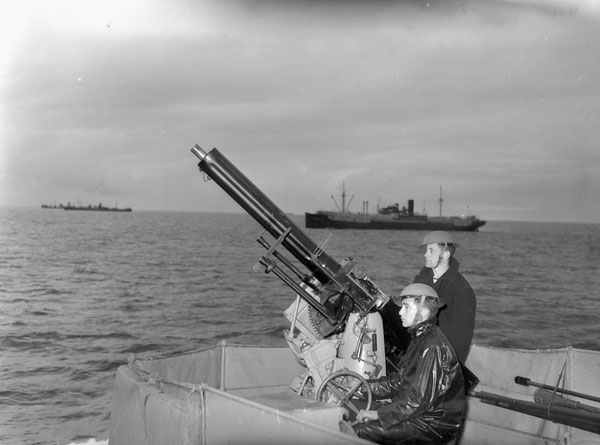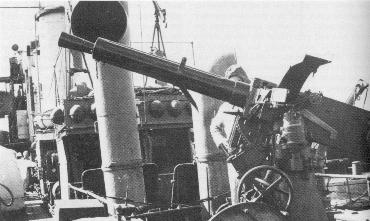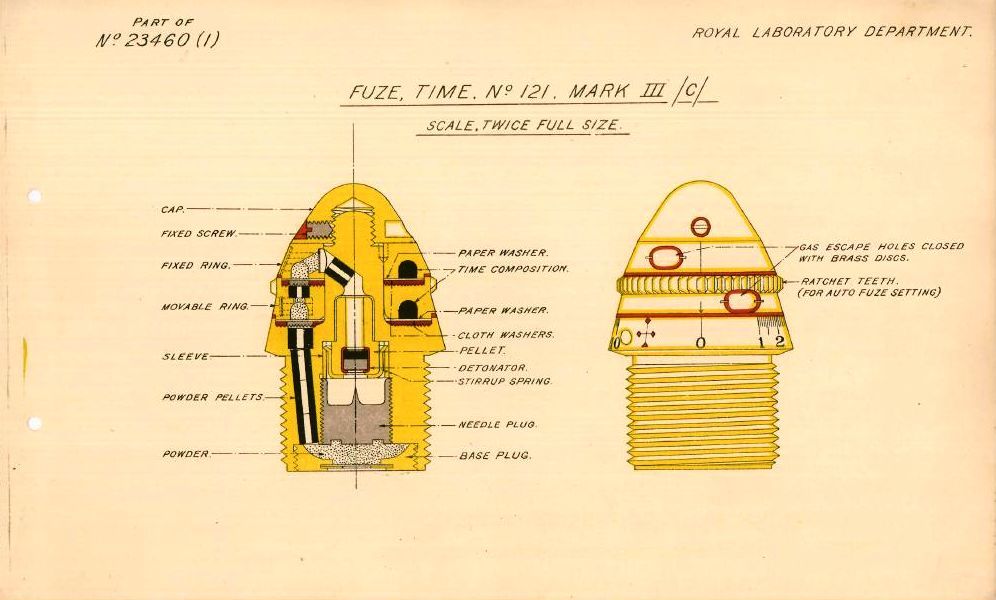
Introduced to the Royal Navy in March of 1915 as a large-caliber AA MG. Generally similar to the later 2-pdr Mark VIII including using the same water-cooled barrel, but the automatic mechanism was lighter and less robust. As introduced, these guns used 25-round fabric belts. Used only in single mountings. Britain produced a total of 795 guns of which 577 were still available in 1939.
The original Mark II design was prone to many faults and the Mark II* was a modified version which improved reliability. Stoppages and jams were still frequent in these models, as the rounds slipped out of their holders and the fabric belts often stretched and tore. The Mark II*C was a further modification which used a 14-round steel-link belt instead of the fabric belt. These steel-link belts were also used on the later 2-pdr. Mark VIII guns.
Some fifty of these guns were sold to the Italian Navy. They were then manufactured under license by Terni (Italy) until the early 1930s. The Terni version used a 50 round ammunition box.
During the 1920s, Vickers made a slightly modified version and sold it to Japan where it was designated as the 40 mm/62 Type 91 "BI" Gun.
Russia ordered a number of these guns from Vickers during World War I and by 1916 forty of them were on hand in the Russian Navy (20 each in the Baltic and Black Sea fleets). In 1916 the Russian Navy ordered sixty additional guns from the Obukhov factory with at least twelve of them being delivered by 1917. All of these weapons used 25 round belts.
There was also an earlier Mark I version, but I lack details as to what were the differences between it and the Mark II.
Actual bore length was 39.37 calibers for all weapons.
The data that follows is for the British version except where otherwise noted.
| Designation | Britain: Vickers 2-pdr QF Mark II, Mark II* and Mark II*C
Italy: 40 mm/39 Vickers-Terni 1915/1917 Russia: 40 mm/39 Vickers Automatic Model 1914 |
|---|---|
| Ship Class Used On | Many |
| Date Of Design | about 1914 |
| Date In Service | Britain: 1915
Italy: about 1917 Russia: 1915 |
| Gun Weight | Britain: 550 lbs. (249 kg) including cooling water
Italy: 550 lbs. (249 kg) including cooling water Russia: 504.9 lbs. (229 kg) (probably does not include water) |
| Gun Length oa | 96.0 in (2.438 m) |
| Bore Length | 62.0 in (1.575 m) |
| Rifling Length | 54.84 in (1.293 m) |
| Grooves | (12) 0.0141 in deep x 0.322 (0.358 x 8.18 mm) |
| Lands | 0.894 in (2.271 mm) |
| Twist | Uniform RH 1 in 30 |
| Chamber Volume | 9.98 in3 (0.165 dm3) |
| Rate Of Fire | 200 rounds per minute cyclical
about 50 - 75 rounds per minute practical |
| Type | Fixed |
|---|---|
| Weight of Complete Round 1 | HE: 2.95 lbs. (1.34 kg)
CP: 2.95 lbs. (1.34 kg) |
| Projectile Types and Weights | HE 2: 2.0 lbs. (0.9 kg)
CP: 2.0 lbs. (0.9 kg) |
| Bursting Charge | HE: 0.21 lbs. (0.100 kg)
CP: 0.05 lbs. (0.023 kg) |
| Projectile Length | N/A
Complete round: 11.995 in (30.47 cm) |
| Propellant Charge | 0.206 lbs. 0.09 kg) Cordite Mark I (7.5)
0.243 lbs. (0.11 kg) HSCT/K 134-055 |
| Muzzle Velocity | Britain: 1,920 fps (585 mps)
Italy: 2,000 fps (610 mps) Russia: 1,972 fps (601 mps) |
| Working Pressure | 15.5 tons / in2 (2,440 kg / cm2) |
| Approximate Barrel Life | 5,000 rounds |
| Ammunition stowage per gun | Britain:
Danae and Emerald: 800 rounds County class: 1,000 rounds Monitors of World War I: 1,000 rounds Others: N/A Italy:
Russia
|
- ^HE projectiles were also known as "Common" and CP projectiles were later known as "SAP" projectiles.
- ^Complete breakdown of HE shell weight from "Q.F. High Explosive 2 pdr Mark II N Shell":
Empty body: 1.45 lbs. (0.66 kg)
Driving band: 0.875 oz (0.025 kg)
Paint: 0.125 oz (0.0035 kg)
Bursting charge: 2.5 oz (0.071 kg)
Fuze No 131: 5.25 oz (0.15 kg)
Total filled: 2 lbs. (0.9 kg)
HE projectiles were originally issued during World War I with direct action (impact) fuzes such as Fuze No. 131 mentioned above that were sensitive enough to detonate when hitting an aircraft fabric covering. Some time later they were issued with dual-action fuzes that had both impact and time operation. As can be seen on the adjacent sketch of the No. 121 Fuze, these had a knurled ring on the fuze body which was used to set the fuze time. My understanding is that the gun mounting had a toothed bar which spun the ring as the ammunition belt was pulled across it by the gun. The crewman operating the fuze setter could move the bar so as to change the number of teeth that engaged the ring as it passed over the bar and thus set the time.
The operational concept was that the crewman operating the fuze setter could observe the shell bursts and "walk" the bursts onto the target. In reality, as the time fuze was by chemical action and these burn at different rates depending upon air-pressure, humidity, temperature and shell orientation, the timing was not precise enough to ensure that the bursts would be close enough together to damage the target, even if they were set perfectly. Finally, the 2-pdr projectile had a very small burster and thus a low lethal radius which meant that even a close burst was unlikely to seriously damage the target. As aircraft speeds increased during the 1930s and aircraft fabric coverings gave way to metal skins, the impracticality of this approach became even more apparent. As a result, the time function was abandoned and only the impact function was used.
The later 2-pdr Mark VIII guns and mountings used the same HE projectiles (now known as the "LV Type") but to the best of my knowledge they were not equipped with fuze setters. Existing LV rounds still in stock were used up during the war. New production of LV Type and later HV Type projectiles used standard impact fuzes such as the Fuze No 243 Mark IIN shown in the Additional Pictures section on the 2-pdr. Mark VIII datapage.
| Elevation | Distance |
|---|---|
| 45 degrees | 3,800 yards (3,475 m) |
| Maximum Effective Range | 1,200 yards (1,100 m) |
| AA Ceiling | N/A |
The Italian shell was self-destructing at 4,900 yards (4,475 m), which implies that it had a range of at least that far.
| Designation | Britain
Mark II and Mark II* Guns: Mark II HA 1a Mark II*C Guns: Mark II*C HA 2a Mark XV 3a Italy
Russia
|
|---|---|
| Weight | Britain
Mark II: 1,568 lbs. (711 kg) Mark II*C: 1,623 lbs. (736 kg) Italy
Russia
|
| Elevation | -5 / +80 degrees |
| Elevation Rate | Manually operated, only |
| Train | 360 degrees |
| Train Rate | Manually operated, only |
| Gun recoil | N/A |
- ^Early mounts had a single gunlayer who had both elevation and training handwheels. Later mounts added a trainer with a single handwheel but the gunlayer retained both of his handwheels. Most of these mountings had both the gunlayer and trainer sitting down, but some were designed such that they stood up.
- ^The Mark II*C modifications were for using the steel-link belts.
- ^Mark XV was a powered mounting similar to the Mark XVI mounting for the the 2-pdr. Mark VIII. Twenty-eight were produced during World War II and the surviving twenty-three were scrapped in early 1944.




The Vickers Photographic Archive - See Vickers Pom Pom and photograph numbers 2836 and 2837 (This is my best guess, but these last two photographs may actually be Mark VIII or Japanese guns).
"The Italian Navigatori Class, 1926" article by Elio Andò in "Warship Special 2: Super Destroyers" edited by Antony Preston
"Big Gun Monitors: The History of the Design, Construction and Operation of the Royal Navy's Monitors" by Ian Buxton
"Naval Weapons of World War Two" by John Campbell
"L'artiglieria Italiana nella Grande Guerra" (Italian Artillery of the Great War) by Andrea Curami and Alessandro Massignani
"British Cruisers of World War Two" by Alan Raven and John Roberts
"Entsiklopedia Otechestvennoi Artillerii" (Encyclopedia of Fatherland (Russian) Artillery) by A.V. Shirokorad
---
"O.U. 5267: Ammunition Pocket Book 1924" by Admiralty, S.W. 1 (Gunnery Branch)
"Q.F. High Explosive 2 pdr Mark II N Shell - Forged Steel with Fixing Screw. Design." No. 21,071.c.(1) / A.D.G.S/3/164 dated 24 February 1916
---
Special help from Vladimir Yakubov, Caspar Vermeulen and Anthony G. Williams
02 March 2007 - Benchmark
29 May 2010 - Added notes on Mark I and Mark II*, fixed typographical error
29 August 2011 - Added picture of River class destroyer
28 November 2015 - Changed Vickers Photographic Archive links to point at Wayback Archive
18 March 2019 - Converted to HTML 5 format, added CP projectile data, reorganized notes, added photographs of Australian
and Canadian weapons, added Dual Action Fuzes section, added mounting notes regarding changes to the Mark II and Mark
II*C mountings
03 October 2022 - Added link to Japanese version

